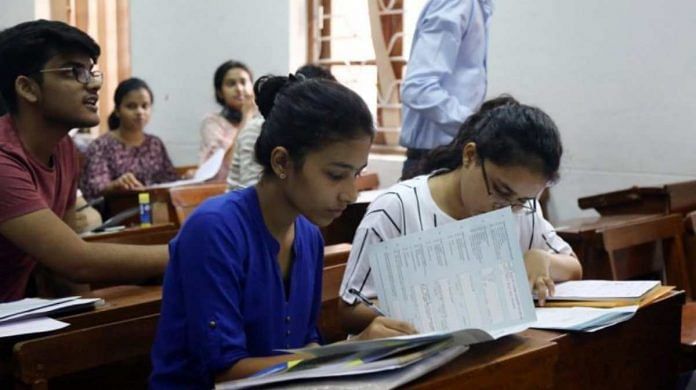New Delhi: The University Grants Commission (UCG) should now take an “outcome-based approach in the higher education sector” in order to increase enrolment of Scheduled Caste and Scheduled Tribe students in undergraduate programmes, a parliamentary panel has suggested.
The panel on education came to this conclusion after the Gross Enrolment Ratio (GER) of SC and ST students at the undergraduate level was found to be 23 per cent and 17.2 per cent respectively, compared to the national average of 26.3 per cent.
The panel said it “feels that the measures and schemes explained by UGC remain either under-utilised or unimplemented”.
The remarks were part of the committee’s report — uploaded on the Rajya Sabha website — which was submitted to the Department of Higher Education, Ministry of Education, earlier this month.
“As per the AISHE Report (2018-2019), the highest number of students is enrolled at undergraduate level across India. Out of the 79.8 per cent of the total enrolments, the Scheduled Caste students constitute only 14.9 per cent and Scheduled Tribe students constitute only 5.5 per cent of the total enrolment,” the committee said.
“Further, the percentage of SC/ST students enrolled in postgraduate programmes and integrated PhDs/PhDs are not known. Most of the colleges run only undergraduate level programmes. Only 2.5 per cent of colleges run PhD level programmes and 34.9 per cent of colleges run postgraduate level programmes,” it added.
The panel further said that it be informed about the Revitalising Infrastructure and Systems in Education (RISE) scheme, which was introduced in 2018 to build new infrastructure to implement 10 per cent reservation for the Economically Weaker Sections.
The UGC in its response, which is also a part of the report, said several steps have been taken to ensure the inclusion of not just SC\ST\OBC candidates, but also of students with disabilities.
Experts, meanwhile, said the low enrolment of SC/ST students at the UG level has been a trend ever since the implementation of the reservation policy.
Also read: Education levels of SC, ST, OBC rising. A new study looks at caste gap in jobs, income too
Actions taken by UGC
According to the UGC, “In order to ensure that there is no discrimination against the SC/ST students, the commission has notified UGC (Promotion of Equity in Higher Education Institutions) Regulation 2012.”
The objective of the regulation is to safeguard these students from all forms of harassment.
The UGC also mentioned that it is reassessing the Education Quality Upgradation and Inclusion Programme (EQUIP) for implementation. EQUIP addresses the need to bridge the gap between SC/ST and general category students.
The UGC also said that centres for study of social exclusion and inclusive policy have been established across universities.
The objective of these centers is to establish links with civil society organisations engaged in combating social exclusion, and teaching courses about social inclusion at MA and PhD levels. They also conduct workshops, seminars on the theme of social exclusion, undertake empirical studies with theoretical perspective and build a data bank for comparative studies and policy/programme evaluation.
The UGC said it has also given a one-time grant of Rs 2 lakh for establishing the office of the Equal Opportunity Cell (EOC) in universities and an amount of Rs 75,000 and Rs 55,000, respectively, in UG and PG colleges, the report said.
The EOCs are mandated to oversee the effective implementation of policies and programmes for the disadvantaged groups and to provide them guidance and counselling in academic, financial and social matters.
‘Need to use horizontal approach to attract SC/ST students’
Citing several social and economic factors behind low enrolment of SC/ST students, some professors told ThePrint that this has been the norm ever since the implementation of the reservation policy.
Dheeraj Sanghi, director of Punjab Engineering College, said, “In government institutions, it is mandatory that they admit students to fill their reservation seats, but what is the guarantee that all private institutions will do the same?”
“Since their fee is high, most of the reserve candidates from poor financial backing are immediately eliminated. On the other hand, students from SC\ST community living in the urban areas may have better access to coaching and other learning mediums as compared to their rural counterparts. This then transcends from being a caste issue to an economic issue.”
Subodh Mehta, assistant professor at Delhi University, said that “ever since the implementation of the reservation act, the number of seats in reserved categories have been unable to be completely full”.
“There are several reasons behind this. The first being the lack of SC\ST administrative heads in the universities, with professors from other categories having no understanding of the issues that need to be addressed for such students. Instead of a top down approach, the universities need to use a horizontal approach in order to attract SC\ST students from rural and backward areas,” he added.
“The need is for the establishment of awareness programmes and guidance workshops for students in rural areas to facilitate them to be able to get to the gates of universities at undergraduate level,” Mehta said.
Sonajharia Minj, vice-chancellor of Sido Kanhu Murmu University in Dumka, Jharkhand, and a former JNU professor, told ThePrint, “Often times it is not just the lack of facilities that stops students from entering the formal education system, but post-enrolment, the lack of a supportive ecosystem is what forces them to leave it.”
Also read: UGC wants university students to write 25 Feb ‘cow science’ exam, asks V-Cs to promote it



